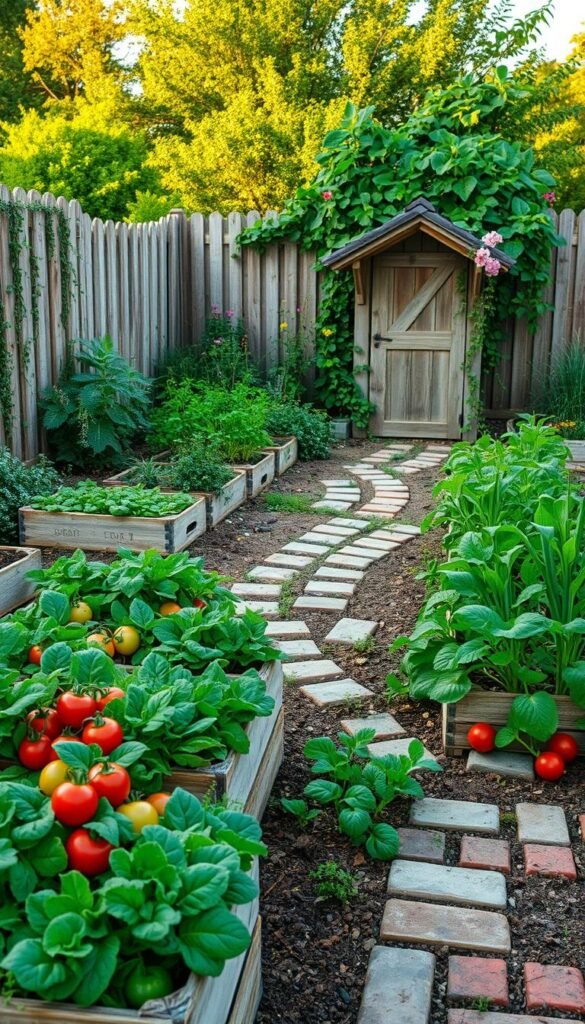Imagine turning everyday items gathering dust in your garage into a thriving edible oasis. With over 146 million tons of waste dumped in U.S. landfills annually—enough to fill 40,000 Olympic pools—repurposing materials isn’t just creative. It’s a game-changer for your wallet and the planet.
You don’t need fancy supplies to grow fresh food. Old buckets become planters. Cracked dishes transform into garden markers. Even worn-out shoes can sprout herbs! This approach keeps tons of plastic and metal out of landfills while giving your space unique charm.
Thousands have already proven it works. One gardener grew tomatoes in stacked rain boots. Another used salvaged wood to build raised beds for under $10. Like these innovators, you’ll discover how to create stunning container setups without overspending.
We’ll show you tested methods to:
• Spot hidden potential in “junk”
• Combine function with personality
• Grow more while spending less
Great growing spaces aren’t about price tags—they’re about smart choices. Ready to turn trash into treasure? Let’s dig in.
Starting Your Budget-Friendly Garden Journey
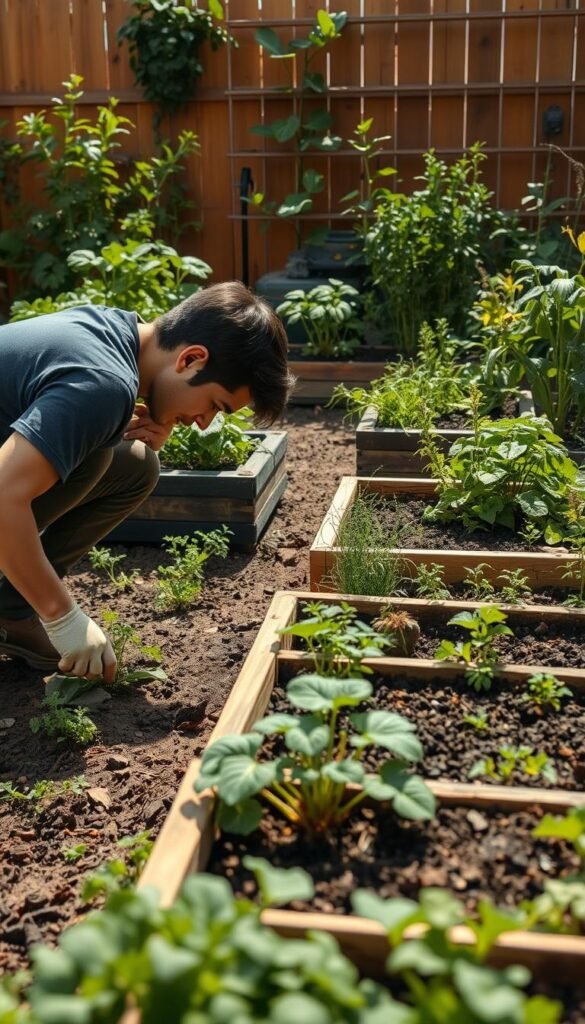
The key to a successful harvest lies in optimizing your home’s outdoor potential. Begin by walking your yard with fresh eyes—look for flat space that gets 6-8 hours of direct sunlight. Morning light matters most for vegetables, so track shadows using sticks as markers.
Assessing Your Garden Space and Sunlight
Use this simple three-step method:
- Sketch your area on graph paper (1 square = 1 foot)
- Note sunlight patterns at 9 AM, noon, and 3 PM
- Mark problem spots like puddles or tree roots
“I started with just 4×4 feet—now I grow enough kale for my family all summer.”
Identifying Essential Materials on Hand
Before buying supplies, raid these spots:
| Location | Common Finds | Garden Uses |
|---|---|---|
| Garage | Buckets, boards | Planters, bed frames |
| Shed | Old tools, wire | Stakes, trellises |
| Backyard | Rocks, bricks | Edging, pathways |
Start small—a 3-foot circle works wonders for herbs. Document your plan with photos or sketches. You’ll save time and money while learning what thrives in your unique space.
Choosing Reusable and Recycled Materials for Your Garden
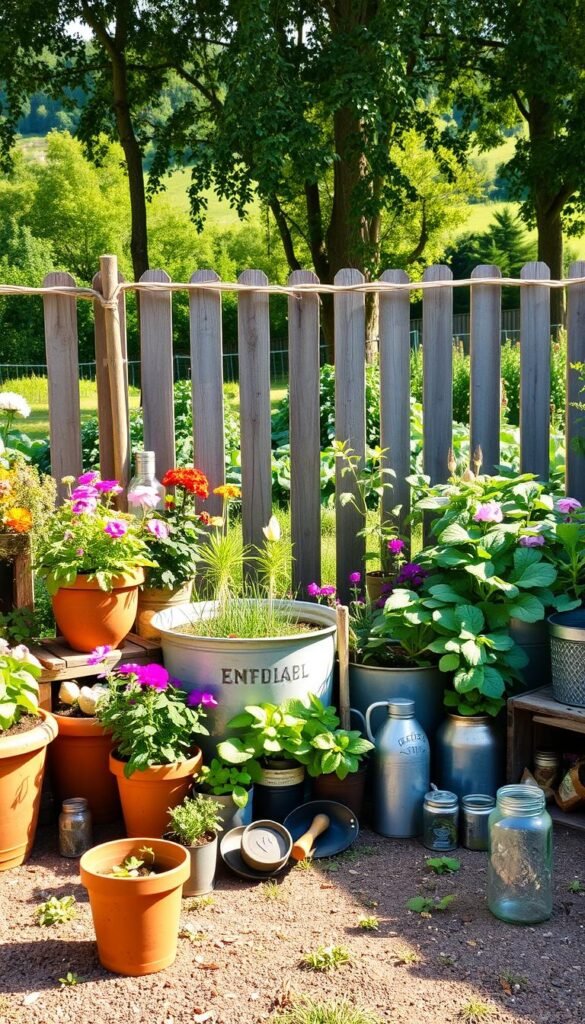
Your backyard can become a sustainability showcase with items others toss aside. Hardware stores and farms often discard perfect growing containers—you just need to know where to look.
Transforming Wood Pallets and Feed Bunks
Free wood pallets make fantastic vertical planters. Check for these safety markers first:
- Look for “HT” stamps (heat-treated, not chemical)
- Avoid cracked boards or protruding nails
- Scrub with vinegar-water before planting
Livestock feed bunks work magic as instant raised beds. Their metal construction lasts decades, and drainage holes come pre-drilled. One Montana gardener shares:
“My cattle troughs grew 40 lbs of potatoes last season—they’re practically indestructible!”
Exploring Concrete, Cinder Blocks, and Other Affordable Options
Concrete blocks create modular growing systems. Arrange them with open cells facing up to plant herbs in each cavity. Benefits include:
- No rot or pest damage
- Retains heat for early spring planting
- Stackable for tiered designs
| Material Source | Best For | Prep Needed |
|---|---|---|
| Construction sites | Cinder blocks | Brush off debris |
| Landscapers | Broken pavers | Check for sharp edges |
| Farm auctions | Galvanized tanks | Drill drainage holes |
Mix materials for visual interest—try pairing rustic wood with sleek metal. Your garden becomes a living collage of creative problem-solving.
Veggie Garden Design on a Budget: Reusing Materials and Resources
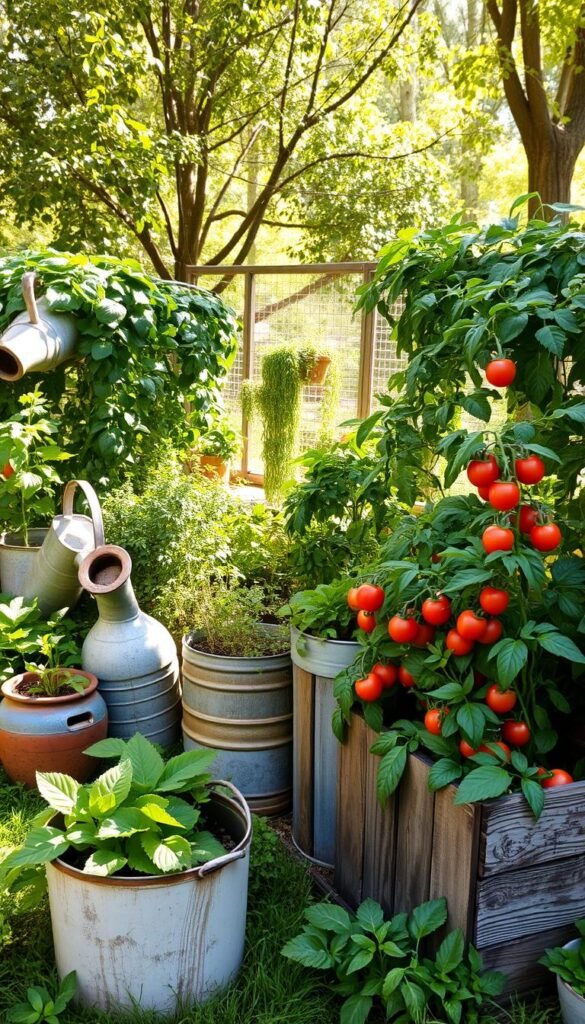
Savvy growers know that yesterday’s junk is today’s gardening goldmine. Repurposing materials cuts costs while sparking creativity—your plants thrive in containers that tell stories instead of draining wallets.
Understanding the Benefits of Repurposed Items
Transforming discarded objects slashes expenses dramatically. A Minnesota family built eight raised beds using salvaged bricks and shipping pallets—their total cost? Just $14 for soil. Commercial equivalents would’ve exceeded $600.
Reused materials often outperform store-bought options. Metal troughs drain faster than plastic planters, while concrete blocks protect roots from summer heat. As one urban gardener notes:
“My tomato yield doubled when I switched to cinder block beds—they retain warmth better than wood.”
Environmental perks multiply the rewards. Every reused item keeps 4.4 lbs of waste from landfills daily. Imagine the impact when your entire garden comes from reclaimed resources!
| Material | Cost New | Repurposed Cost |
|---|---|---|
| Raised Bed Kit | $120 | $0 (pallet wood) |
| Planters | $25 each | Free (buckets) |
| Edging | $3 per foot | Salvaged bricks |
Unconventional combos become neighborhood showstoppers. Try painting old tires bright colors and filling them with herbs. Stack mismatched containers for a cascading vegetable display. Since you’re not spending money on materials, you can afford to experiment wildly!
Creative DIY Raised Garden Beds Ideas
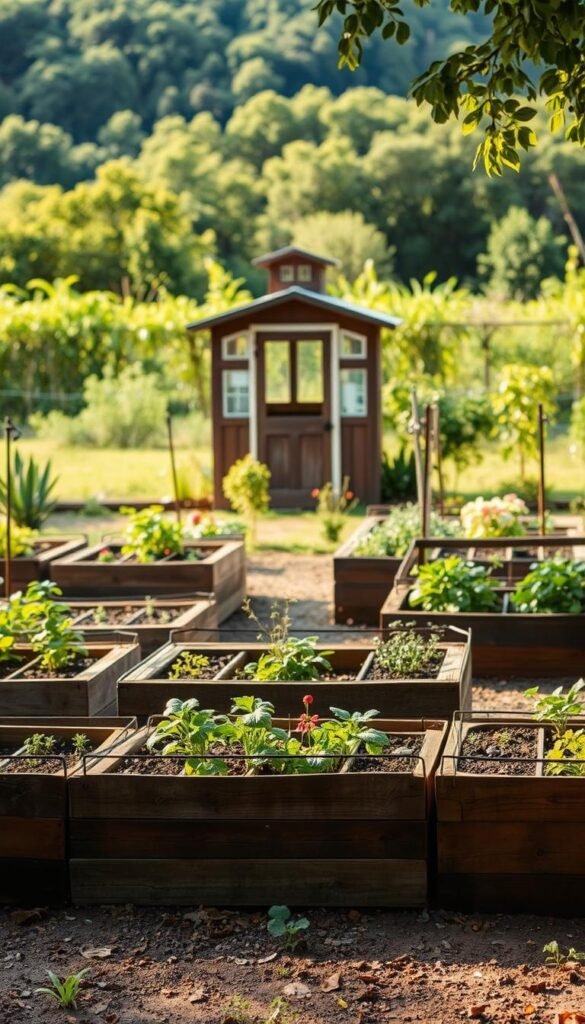
Your next harvest could sprout from forgotten treasures hiding in storage spaces. Let’s transform overlooked items into functional raised beds that boost yields while keeping costs near zero.
Step-by-Step Guide to Building Upcycled Planters
Start with stacked tires for deep-rooted veggies like carrots. Here’s how:
- Clean tires thoroughly with soapy water
- Drill 10-12 drainage holes in each bottom layer
- Stack 2-3 tires, filling each with ⅔ gravel and ⅓ soil
Old dressers become instant multi-level garden beds. Remove drawers, line shelves with landscape fabric, and fill compartments with potting mix. One Texas gardener shares:
“My upcycled dresser grows 14 herb varieties—it’s like having a spice rack outdoors!”
Incorporating Unique Elements Like Old Furniture and Tires
Clawfoot tubs make excellent raised beds for water-loving plants. Their built-in drains prevent soggy roots. For safety:
- Test porcelain tubs for lead paint
- Seal wooden furniture with food-safe linseed oil
- Line metal containers with burlap to prevent soil contact
| Material | Best Plants | Prep Time |
|---|---|---|
| Tires | Root vegetables | 30 minutes |
| Dressers | Herbs, greens | 1 hour |
| Bathtubs | Squash, melons | 45 minutes |
Combine materials for visual drama—try pairing a painted tub with tire planters. These systems let you grow more while spending less on traditional beds.
Innovative Projects for Repurposing Garden Planters
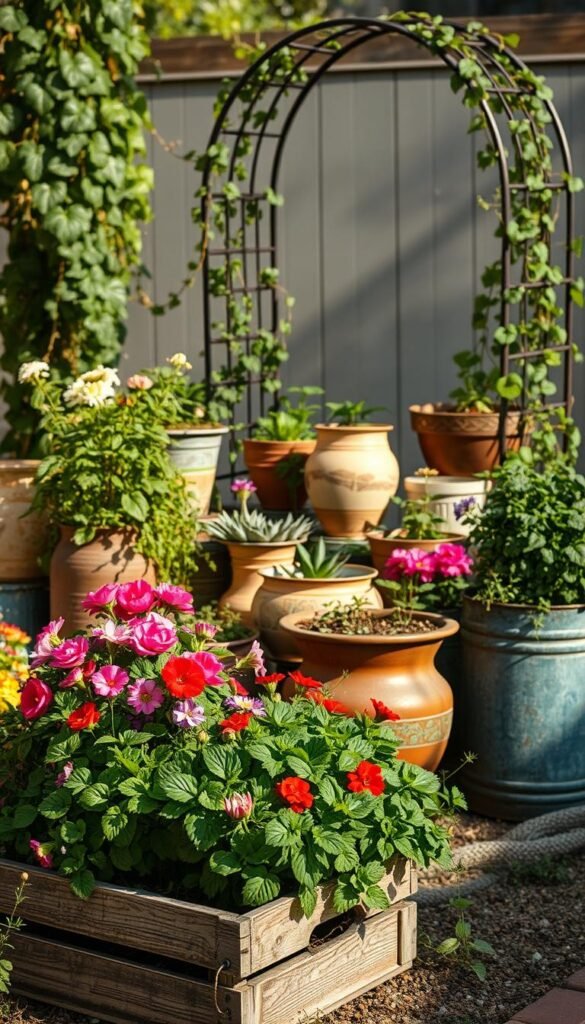
Your unused household items hold hidden potential for growing fresh produce. With clever tweaks, ordinary objects become extraordinary growing spaces that nourish plants while reducing waste.
Reusing Stock Tanks and Feed Bunks
Galvanized stock tanks make perfect containers for tomatoes or peppers. Drill 5-8 drainage holes in the bottom using a ¼” metal bit. Line the base with gravel before adding soil—this improves water flow and prevents root rot.
Feed bunks offer instant depth for root vegetables. One Iowa grower reported:
“My 8-foot feed bunk yielded 60 lbs of potatoes last fall—triple my old wooden bed’s output!”
Crafting Planters from Glass Bottles and Tin Tubs
Turn wine bottles into decorative garden edging:
- Dig a 6-inch trench along your bed
- Place bottles neck-down at 45° angles
- Pack soil tightly around bases
Tin tubs become self-watering systems when you add a plastic bottle reservoir. Cut the bottom off a 2-liter bottle, invert it, and bury it beside your plants. Refill weekly for consistent moisture.
| Container Type | Best For | Prep Steps |
|---|---|---|
| Stock tanks | Tomatoes, squash | Drill drainage |
| Glass bottles | Herbs, flowers | Clean thoroughly |
| Paint cans | Salad greens | Add holes |
Milk jugs shine as watering tools. Pierce the cap with 10-15 tiny holes—this creates gentle showers that won’t disturb seedlings. For vertical growth, mount cleaned tin cans on fences using sturdy brackets.
Practical Tips for Integrating Recycled Materials
Repurposed containers give your plants personality, but they need smart care to thrive. Let’s explore how to keep your upcycled setup productive through every season.
Maintaining Soil Health and Proper Drainage
Drill ½-inch holes every 6 inches in container bottoms. Layer 2 inches of gravel or broken pottery beneath soil to prevent waterlogging. For wooden boxes, line interiors with landscape fabric to retain moisture without rot.
Mix equal parts compost, coconut coir, and perlite for a nutrient-rich growing medium. Test drainage by pouring a cup of water—it should drain completely in 60 seconds. One urban gardener shares:
“Adding worm castings to my homemade mix doubled my pepper yields!”
Cost-Effective Watering and Fertilizer Solutions
Transform plastic bottles into drip irrigators:
- Poke 10 holes in a 2-liter bottle cap
- Bury the bottle neck-down near plants
- Fill weekly for slow-release watering
Boost nutrients with kitchen scrap fertilizers:
- Steep used coffee grounds in water for nitrogen tea
- Bake crushed eggshells at 200°F for 20 minutes, then powder
These amendments work particularly well in square-foot gardening setups where soil space is limited. Refresh container soil each spring by mixing in 30% new compost—your plants will reward you with vigorous growth.
Eco-Friendly Landscaping Techniques That Save Money
Your soil holds the secret to growing lush plants without draining your wallet. Simple composting and mulching strategies turn household waste into garden gold while cutting maintenance costs.
Implementing Composting and Mulching Strategies
Try these three ways to compost without bins:
- Bury banana peels and coffee grounds 6 inches deep near tomatoes
- Dig 12-inch trenches between rows for autumn leaves
- Create mobile compost heaps using chicken wire cylinders
Shredded newspaper makes fantastic weed-blocking mulch. Layer 4 sheets thick around plants, then top with grass clippings. This system retains moisture better than store-bought bark chips.
| Compost Method | Materials Needed | Decomposition Time |
|---|---|---|
| Direct Burial | Kitchen scraps | 2-3 months |
| Trench Style | Yard waste | 6-8 weeks |
| Rolling Pile | Mixed organics | 4-6 weeks |
Seasonal maintenance keeps your garden thriving year-round. In spring, mix finished compost into planting beds. Come fall, spread shredded leaves as protective winter mulch. As one Colorado grower notes:
“My rolling compost heaps improved clay soil in one growing season—no tiller required!”
These gardening techniques align with permaculture principles, creating self-sustaining ecosystems. You’ll spend less time battling weeds and more enjoying fresh harvests.
Time-Tested Vegetable Gardening Hacks on a Budget
Your kitchen scraps hold more potential than you think—especially when growing fresh produce. Let’s explore clever ways to nurture your vegetable garden without expensive gear.
DIY Seed Starting Containers and Drip Watering Systems
Transform everyday items into seedling nurseries. Toilet paper rolls become biodegradable pots when folded at the bottom. Egg cartons work perfectly for herbs—just add soil and snip apart when transplanting.
“I grew 50 tomato seedlings in rotisserie chicken containers last spring. They’re free greenhouses!”
Create self-watering systems in three steps:
- Poke 10 holes in a 2-liter bottle cap
- Bury the bottle upside-down near plants
- Fill weekly for steady moisture
Simple Tweaks to Enhance Plant Growth
Boost yields with these strategies:
- Pinch tomato side shoots to focus energy on fruit
- Use old pantyhose as gentle plant ties
- Pair basil with tomatoes to repel pests naturally
Extend your growing season using clear salad containers as mini-greenhouses. For healthy soil foundations, mix coffee grounds into compost—they add nitrogen that leafy greens crave.
| Companion Plants | Benefits | Recycled Support |
|---|---|---|
| Carrots + Onions | Pest control | Milk jug cloches |
| Cucumbers + Nasturtiums | Trap crops | Bamboo stakes |
| Peppers + Marigolds | Root protection | Window screen shade |
Remember: A thriving vegetable garden needs observation more than money. Check leaves weekly and adjust your approach—sometimes moving plants 6 inches sunward makes all the difference.
Balancing Aesthetics and Functionality in Your Backyard
Your outdoor area can bloom with beauty while feeding your family. Start by pairing plants that look stunning together and support each other’s growth. Marigolds shield tomatoes from pests while adding sunny color, and purple basil makes lettuce beds pop with contrast.
Selecting Complementary Plants for Visual Appeal
Choose combos that work double duty. Tall sunflowers create natural trellises for beans, and nasturtiums cascade colorfully over garden edges while repelling aphids. Mix textures like feathery dill with broad kale leaves for visual depth.
Designing Layouts That Maximize Space and Efficiency
Go vertical to multiply your growing power. Install salvaged ladders for climbing peas or stack rustic metal beds against fences. One gardener grew 18 herb varieties in a shoe organizer hung from their shed!
Plan seasonal color waves—cool greens in spring, bright blooms in summer, warm oranges in fall. Use curved pathways lined with recycled bricks to guide eyes through the space. Add a focal point like a painted barrel fountain surrounded by mint.
For year-round charm, tuck evergreens between vegetable rows. These tricks turn functional plots into inviting retreats. Discover more ways to blend style and purpose with creative outdoor decorations that delight the senses.

